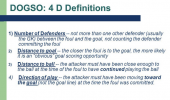Below is a bad drawing of the situation. Red mark is where the tackle took place. And green mark is where the second to last man was. Rest of the opposition was on the other half of the pitch.

This situation happened last Saturday. For me I judged it as a foul and applied a DFK. However if this was DOGSO then a red card should have been awarded to the defending player as it was outside the box. However if we look at the second picture below.

First we we consider the first D for the number of defenders there was only one other (GK) so that condition has been meet, 1/4. Looking at the second D, distance to the goal, had the foul not been commited where it was, was the striker close enough to the goal would he have score. No he was just at the halfway line. So that is still 1/4. The attacker was dribbling/running with the ball at the time. So that is the third condition met, 2/4. And the fourth D, direction of play, the attacker was going straight towards the goal, so that D is met meaning 3/4. Which means out of the 4 D 3 have been meet.
However from my decision I judged it to be a non-dogso however after looking at it with more than 5-10 seconds I have deemed it to potentially have been DOGSO, although distance from the goal is a fit iffy.
Anyone provide some insight as I am not 100% sure. Although I am glad I did not do DOGSO in the match as I would have gotten chastied very much.
Edit: Thanks @Anubis for pointing out the DOGSO definition at the time was inaccurate. Below is the actual definition for DOGSO off IFAB:
Where a player denies the opposing team a goal or an obvious goal-scoring opportunity by a handball offence, the player is sent off wherever the offence occurs (except a goalkeeper within their penalty area).
A player, sent-off player, substitute or substituted player who enters the field of play without the required referee’s permission and interferes with play or an opponent and denies the opposing team a goal or an obvious goal-scoring opportunity is guilty of a sending-off offence.
The following must be considered:
Even after looking at this definition, I still wouldn't have given it as DOGSO during the match. Mainly due to the first point of distance between the offence and the goal

This situation happened last Saturday. For me I judged it as a foul and applied a DFK. However if this was DOGSO then a red card should have been awarded to the defending player as it was outside the box. However if we look at the second picture below.

First we we consider the first D for the number of defenders there was only one other (GK) so that condition has been meet, 1/4. Looking at the second D, distance to the goal, had the foul not been commited where it was, was the striker close enough to the goal would he have score. No he was just at the halfway line. So that is still 1/4. The attacker was dribbling/running with the ball at the time. So that is the third condition met, 2/4. And the fourth D, direction of play, the attacker was going straight towards the goal, so that D is met meaning 3/4. Which means out of the 4 D 3 have been meet.
However from my decision I judged it to be a non-dogso however after looking at it with more than 5-10 seconds I have deemed it to potentially have been DOGSO, although distance from the goal is a fit iffy.
Anyone provide some insight as I am not 100% sure. Although I am glad I did not do DOGSO in the match as I would have gotten chastied very much.
Edit: Thanks @Anubis for pointing out the DOGSO definition at the time was inaccurate. Below is the actual definition for DOGSO off IFAB:
Denying a goal or an obvious goal-scoring opportunity (DOGSO)
Where a player commits an offence against an opponent within their own penalty area which denies an opponent an obvious goal-scoring opportunity and the referee awards a penalty kick, the offender is cautioned if the offence was an attempt to play the ball; in all other circumstances (e.g. holding, pulling, pushing, no possibility to play the ball etc.) the offending player must be sent off.Where a player denies the opposing team a goal or an obvious goal-scoring opportunity by a handball offence, the player is sent off wherever the offence occurs (except a goalkeeper within their penalty area).
A player, sent-off player, substitute or substituted player who enters the field of play without the required referee’s permission and interferes with play or an opponent and denies the opposing team a goal or an obvious goal-scoring opportunity is guilty of a sending-off offence.
The following must be considered:
- distance between the offence and the goal
- general direction of the play
- likelihood of keeping or gaining control of the ball
- location and number of defenders
Even after looking at this definition, I still wouldn't have given it as DOGSO during the match. Mainly due to the first point of distance between the offence and the goal
Last edited:


